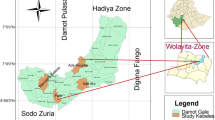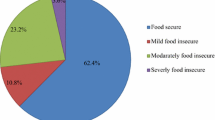Abstract
This study determined the level and causes of food insecurity of 150 households, in the Eastern Cape Province of South Africa using the Household Food Insecurity Access Prevalence (HFIAP) and the Household Food Insecurity Access Scale (HFIAS). The majority (67.7 %) of the households interviewed were severely food insecure, the main cause being the abandonment of own food production. Average HFIAS for the sample was 12.41 and ranged from 0 to 27. Most households were dependent on government social grants for household food requirements rather than own food production or food purchases, using wages and remittances. Households in the study area were net purchasers of food, as is the situation in most rural households of South Africa. High levels of unemployment (97.5 %) among household heads were observed in the study areas. In times of food shortages, most households relied on borrowing from shops against future payment. Most of the food insecurity coping strategies used by the households had long-term detrimental effects. The ultimate way to improve the food security in rural South Africa is to increase per capita incomes and/or ensure that households have the resources and capacity to produce their own food through farming.



Similar content being viewed by others
Notes
During the survey period 1USD was equivalent to ZAR 8.67
References
Aliber, M., & Hart, T. G. B. (2009). Should subsistence agriculture be supported as a strategy to address rural food insecurity? Agrekon, 48(4), 434–458.
Anderson, S. A. (1990). Core indicators of nutritional state for difficult-to-sample populations. Journal of Nutrition, 120, 1557–1600.
Coates, J. (2004). Experience and expression of food insecurity across cultures: Practical implications for valid measurement.”. Washington: Food and Nutrition Technical Assistance Project, Academy for Educational Development.
Coates, J., Swindale, A., & Bilinsky, P. (2007). Household Food Insecurity Access Scale (HFIAS) for measurement of household food access: Indicator guide (v. 3). Washington: Food and Nutrition Technical Assistance Project, Academy for Educational Development.
Constitution of the Republic of South Africa (1996). http://www.info.gov.za/documents/constitution/1996/index.htm. Accessed 13 Apr 2013.
Ellis, F. (2000). Peasant economics, farm household and agrarian development. Newcastle: Cambridge University Press.
Evans, A. (2009). The feeding of the Nine Billion: Global food security for the 21st Century. A chatham house report. London: The Royal Institute for International Affairs.
FAO. (1996). Rome declaration on world food security and world food summit plan of action (pp. 13–17). Rome: World Food Summit.
FAO. (2002). The State of Food Insecurity in the World 2001. Rome.
Frongillo, E. A. (1999). Validation of measures of food insecurity and hunger. Journal of Nutrition, 129, 506S–509S.
Hanjra, M. A., & Qureshi, M. E. (2010). Global water crisis and future food security in an era of climate change. Food Policy, 35, 365–377.
Inglesi-Lotz, R. (2012). The Sensitivity of the South African Industrial Sector’s Electricity Consumption to Electricity Price Fluctuations (pp. 2012–25) University of Pretoria Department of Economics Working Paper.
International Federation of Red Cross and Red Crescent Societies (2006). How to conduct a food security assessment: A step-by-step guide for National Societies in Africa. Online: http://www.ifrc.org/Global/Publications/disasters/food_security/fs-assessment.pdf. Accessed 25 Oct 2013
Labadarios, D., Davids Y.D., Mchiza, Z., & Weir-Smith, G. (2009). The assessment of food insecurity in South Africa (Unpublished paper). Centre for Poverty, Employment and Growth, Human Sciences Research Council.
NDA (2002). The Integrated Food Security Strategy for South Africa. Pretoria. Online: http://www.nda.agric.za/doaDev/sideMenu/foodSecurity/policies.pdf. Accessed Oct 03 2013.
SASSA. (2012). South African Social Security Agency (SASSA) Annual Report 2011/12. http://www.pmg.org.za/report/20121120-annual-report-briefing-south-african-social-assistance-agency-sassa. Accessed 25 Oct 2013.
Stats SA. (2000). Measuring poverty in South Africa. Pretoria: Statistics South Africa.
Stats SA. (2007). The general household survey 2007. Pretoria: Statistics South Africa.
Stats SA. (2011). Census 2011. Pretoria: Statistics South Africa.
Strauss Commission. (1996). Final report of the commission of inquiry into the provision of rural financial services. Pretoria: Government Printer.
Acknowledgments
This paper is based on a pilot study on assessing the food security status of households in the Eastern Cape Province, South Africa. Efforts from the Eastern Cape Food Security and Nutrition Advisory Committee in designing the survey tool are greatly appreciated. The research was undertaken by the Risk and Vulnerability Assessment Centre at the University of Fort Hare, funded by the National Research Foundation of South Africa (NRF) with funds supplied by the Department of Science and Technology (DST), South Africa.
Author information
Authors and Affiliations
Corresponding author
Rights and permissions
About this article
Cite this article
Musemwa, L., Muchenje, V., Mushunje, A. et al. Household food insecurity in the poorest province of South Africa: level, causes and coping strategies. Food Sec. 7, 647–655 (2015). https://doi.org/10.1007/s12571-015-0422-4
Received:
Accepted:
Published:
Issue Date:
DOI: https://doi.org/10.1007/s12571-015-0422-4




